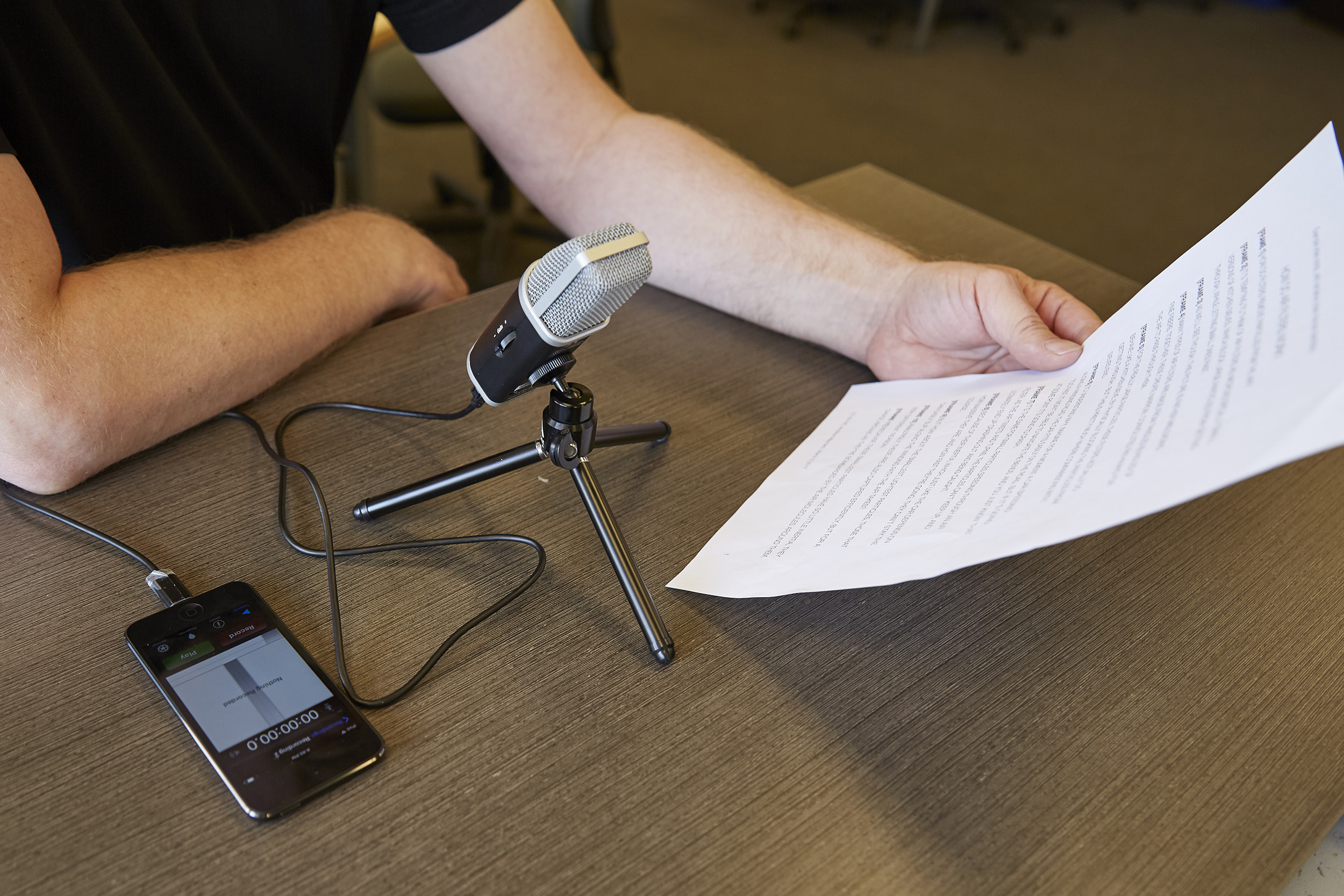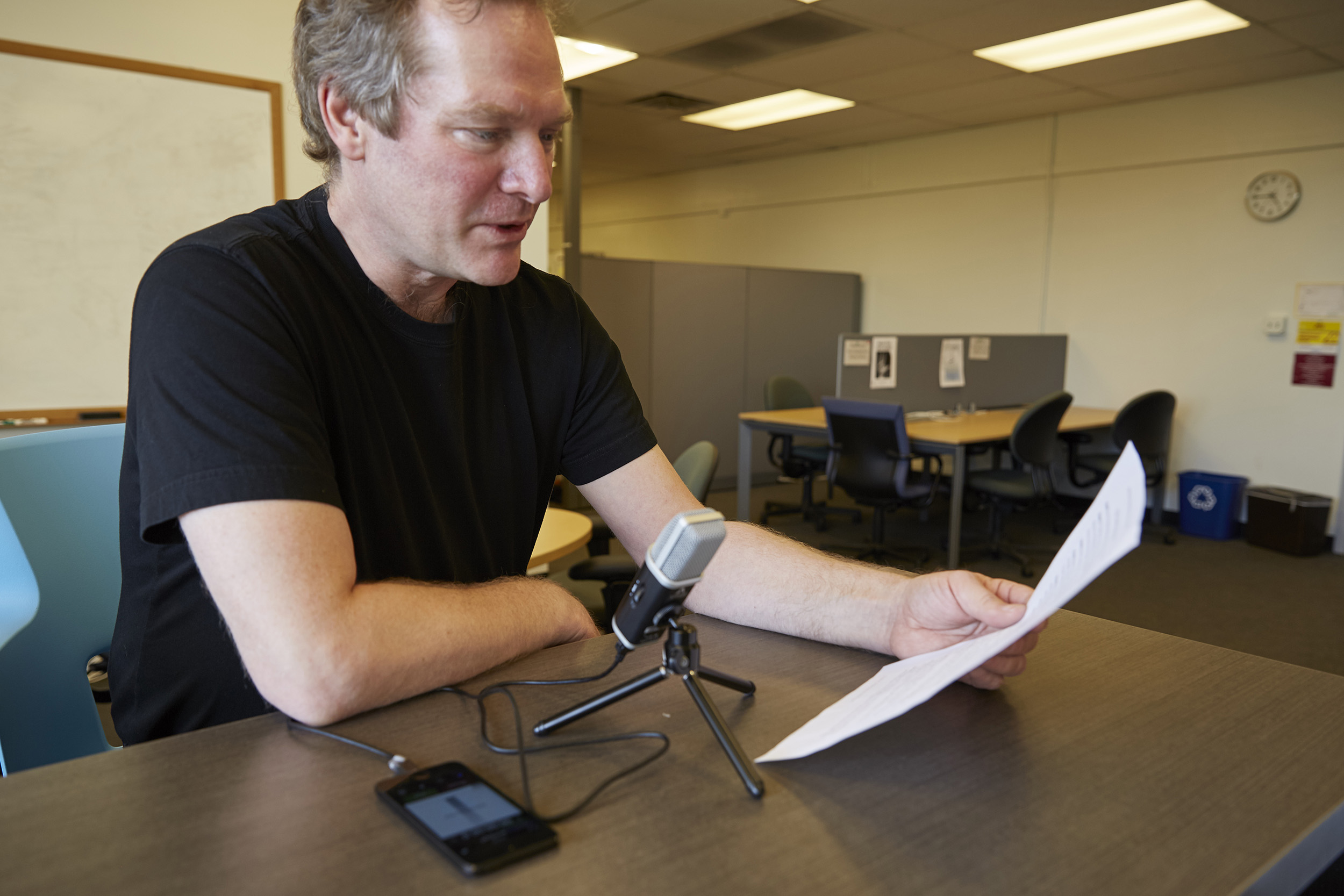SCIENCE VIDEOS MADE SIMPLE
A short guide to making simple whiteboard-style videos for scientists
5. VOICEOVER
This guide was created in early 2017 to guide a bunch of graduate students through the process of creating simple science videos for general audiences using whiteboards, stick figures, and video capture devices like smartphones (we used Apple iPods, which are no longer available, but the techniques still stand).
Since then the available technologies have improved – for instance, most smart phones will record good audio without the help of an external microphone, and recording apps have evolved. But the basic approaches and principles remain the same. For a more in-depth article on the underlying ideas and process, see here.
Having a well-recorded and engaging voiceover is essential to creating effective sketch-style videos. I’d go as far as to say if you get the audio right — and by that I mean a clear, high quality recording of an animated narrator who tells a compelling story — you can get away with an awful lot of deficiencies in the rest of the video!
There are three key aspects to getting the voiceover right, assuming you have a kick-ass script:
- Use a top-notch recording device/microphone;
- Stand close to the microphone in a room that isn’t very reverberant while recording (clothes closets are great for this!); and
- Be animated!
Equipment
Fortunately, smartphones these days come with great recording apps and microphones that are certainly good enough for a decent voiceover. You can get even better results thought using a smartphone with a plugin microphone.
For instance, in the workshops that these modules were originally developed for, we use iPods as substitutes for smartphones, and a range of different types of plugin microphones made by Shure, RØDE and Apogee. This module descrobes the use of these devices, but the concepts can be extended to the use of ant smartphone/recording device.

Using a connected stereo plugin microphone with the iPod — Rode XY

Using a connected stereo plugin microphone with the iPod — Apogee MiC
Positioning
Microphones pick up more of the ambience of the space you’re in than you’d imagine, and as a result, recordings can easily turn out sounding like they were recorded in a tin can.
To avoid this you should try and find a space that is acoustically dry. Large spaces, or offices with plenty of books and even soft hangings on the walls work well. Even better — use a clothes closet if you can!
To reduce unwanted ambience, it’s important to stand as close to the microphone as possible while recording — ideally with your mouth just a few inches from it. Because this then leads to the problem of the mic picking up noise from your breath, you should try and use a windshield.
Mount the iPod on a tripod to make it easy to position yourself close to the mic while reading from the script.


Getting this close or even closer (with the desk mic on the right) can help increase clarity and reduce the “tinniness” or reverberation on recordings.
Recording Apps
(This section may be outdated as apps move on!) There’s a good summary of voice recorder apps for smartphones here. Below are apps that I’ve played around with on the iPhone:
Voice Memos: This is the built in audio memo app on the iPhone. I haven’t used it much, and so don’t know how good the audio quality is. This is one of the simpler apps to use. However, unless you have a Mac, exporting the files is a bit tricky.
Recorder: This is also designed as an audio memo app, but the quality is pretty good (make sure you select “high quality” in the settings before recording). Files can be exported to DropBox with a wireless connection, but are otherwise a little tricky to export.
RØDE Rec: This app is designed to go with the RØDE XY microphone, although it works with some other mics. Before recording, you need to adjust the gain so that the recording levels are sufficiently high. The quality is good with this app, but you need an internet connection to transfer files to your computer.
MetaRecorder: This is the app that goes with the Apogee mic, although it should work with other mics. As with other apps, exporting recordings isn’t that straight forward. There’s a DropBox sync option, and also an AirDrop option if you have a Mac.
Getting ready to record
Before you start recording for real:
- Make sure your smartphone and microphone are correctly set up, and the appropriate app is open.
- Make sure the mic is working! It may seem obvious, but it’s really easy to think you’re recording, just to end up with rubbish … or nothing!
- Make sure the recording levels are set right. At your loudest, the recording meter (if there is one) should be just in the orange – if the levels are too high, the sound will be distorted. Make sure the levels aren’t too low, or the voiceover will be too quiet.
- Record a test section, and make sure it’s loud enough, it’s clear enough, it doesn’t sound echoey, and it isn’t distorted.
Recording an engaging voiceover
Voiceovers need to be engaging to keep listeners interested. We all know how deadly a monotone lecturer is — this is also the kiss of death with voiceovers.
If you’re not used to recording yourself (more on this below), you’ll need to be more animated than feels natural. Make a conscious effort to change the pitch of your voice and the pace of your delivery, and place more emphasis than you think is necessary on parts of the script you want to emphasize.
When reading the script, think about how to convey the meaning of each sentence and paragraph and the story as a whole with the variation in your voice — there’s a reason this is called voice-acting!
If you’re not used to hearing yourself on recordings, you’ll most likely think you don’t sound like yourself, and you may well be embarrassed. Trust me here — you will sound like yourself to others. This is one of those things you just need to get over and trust others on.
This is really important, because if you’re embarrassed or hesitant, this will prevent you from recording a voiceover that is engaging to viewers.
One thing you’ll have to experiment with is pace of delivery. Conventionally, voiceovers used to be recorded at a steady pace so that listeners could keep up. However, there’s a growing trend in rapid delivery in voiceovers. Both work, but both have to be done right to work.
It’s worth watching a few videos (for instance Hank Green on SciShow and Henry Reich on Minute Physics, as well as me on the example video for the workshop). This’ll give you an idea of what you like, and what might work for you.
Ultimately though, finding your groove with voiceover deliver comes down to practice — repeatedly recording and listening, and asking others what they think.
Next …
Modules:
Back to the OVERVIEW
